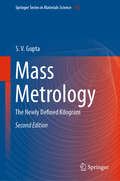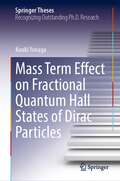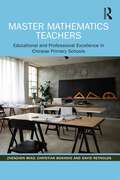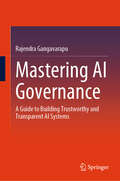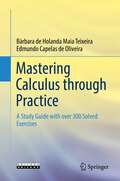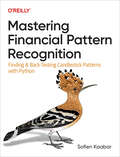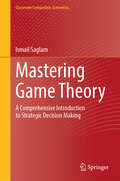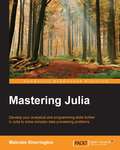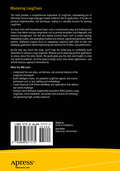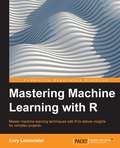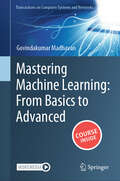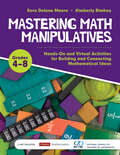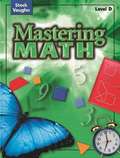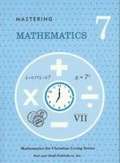- Table View
- List View
Mass Dimension One Fermions (Cambridge Monographs on Mathematical Physics)
by Dharam AhluwaliaIn 2005, Dharam Ahluwalia and Daniel Grumiller reported an unexpected theoretical discovery of mass dimension one fermions. These are an entirely new class of spin one half particles, and because of their mass dimensionality mismatch with the standard model fermions they are a first-principle dark matter candidate. Written by one of the physicists involved in the discovery, this is the first book to outline the discovery of mass dimension one fermions. Using a foundation of Lorentz algebra it provides a detailed construction of the eigenspinors of the charge conjugation operator (Elko) and their properties. The theory of dual spaces is then covered, before mass dimension one fermions are discussed in detail. With mass dimension one fermions having applications to cosmology and high energy physics, this book is essential for graduate students and researchers in quantum field theory, mathematical physics, and particle theory.
Mass Metrology (Springer Series in Materials Science #155)
by S. V. GuptaThis second edition of Mass Metrology: The Newly Defined Kilogram has been thoroughly revised to reflect the recent redefinition of the kilogram in terms of Planck’s constant. The necessity of defining the kilogram in terms of physical constants was already underscored in the first edition. However, the kilogram can also be defined in terms of Avogadro’s number, using a collection of ions of heavy elements, by the levitation method, or using voltage and watt balances. The book also addresses the concepts of gravitational, inertial and conventional mass, and describes in detail the variation of acceleration due to gravity. <P><P> Further topics covered in this second edition include: the effect of gravity variations on the reading of electronic balances derived with respect to latitude, altitude and earth topography; the classification of weights by the OIML; and maximum permissible error in different categories of weights prescribed by national and international organizations. The book also discusses group weighing techniques and the use of nanotechnology for the detection of mass differences as small as 10-24 g. Last but not least, readers will find details on the XRCD method for defining the kilogram in terms of Planck’s constant.
Mass Term Effect on Fractional Quantum Hall States of Dirac Particles (Springer Theses)
by Kouki YonagaThis book presents the high-precision analysis of ground states and low-energy excitations in fractional quantum Hall states formed by Dirac electrons, which have attracted a great deal of attention. In particular the author focuses on the physics of fractional quantum Hall states in graphene on a hexagonal boron nitride substrate, which was recently implemented in experiments. The numerical approach employed in the book, which uses an exact numerical diagonalization of an effective model Hamiltonian on a Haldane’s sphere based on pseudopotential representation of electron interaction, provides a better understanding of the recent experiments. The book reviews various aspects of quantum Hall effect: a brief history, recent experiments with graphene, and fundamental theories on integer and fractional Hall effects. It allows readers to quickly grasp the physics of quantum Hall states of Dirac fermions, and to catch up on latest research on the quantum Hall effect in graphene.
Massive Graph Analytics (Chapman & Hall/CRC Data Science Series)
by David A. BaderExpertise in massive scale graph analytics is key for solving real-world grand challenges from health to sustainability to detecting insider threats, cyber defense, and more. Massive Graph Analytics provides a comprehensive introduction to massive graph analytics, featuring contributions from thought leaders across academia, industry, and government. The book will be beneficial to students, researchers and practitioners, in academia, national laboratories, and industry, who wish to learn about the state-of-the-art algorithms, models, frameworks, and software in massive scale graph analytics.
Massive MIMO Detection Algorithm and VLSI Architecture
by Leibo Liu Shaojun Wei Guiqiang PengThis book introduces readers to a reconfigurable chip architecture for future wireless communication systems, such as 5G and beyond. The proposed architecture perfectly meets the demands for future mobile communication solutions to support different standards, algorithms, and antenna sizes, and to accommodate the evolution of standards and algorithms. It employs massive MIMO detection algorithms, which combine the advantages of low complexity and high parallelism, and can fully meet the requirements for detection accuracy. Further, the architecture is implemented using ASIC, which offers high energy efficiency, high area efficiency and low detection error. After introducing massive MIMO detection algorithms and circuit architectures, the book describes the ASIC implementation for verifying the massive MIMO detection. In turn, it provides detailed information on the proposed reconfigurable architecture: the data path and configuration path for massive MIMO detection algorithms, including the processing unit, interconnections, storage mechanism, configuration information format, and configuration method.
Master Mathematics Teachers: Educational and Professional Excellence in Chinese Primary Schools
by David Reynolds Zhenzhen Miao Christian BokhoveThis practical guide invites teachers to take a journey towards masterly mathematics teaching using the experiences and lessons learnt across five Chinese provinces, Anhui, Beijing, Jiangsu, Jiangxi and Tianjin. On this journey, you will gain a thorough understanding of: (1) the quality and characteristics of master mathematics teachers’ teaching, (2) the quality of mathematics learning they have nurtured amongst their students in affective, metacognitive and cognitive dimensions and (3) the teaching-learning mechanisms that underpin excellent performance in the three dimensions. Alongside the quantitative and qualitative evidence on educational excellence, you will also delve deep into the trajectories and processes of professional development that generate professional excellence amongst master mathematics teachers and their peers within and across primary schools, up and down China. Building on data collected with 70 master mathematics teachers and 3,178 students and from teaching research events at the school, municipal, provincial and national levels, the Master Mathematics Teachers (MasterMT) project is, to date, the first that has looked at the legendary tribe of master mathematics teachers in China at such a large scale, and with such breadth and depth. The book offers invaluable insights for any teacher or teacher educator who wants to improve mathematics teaching and learning and generate educational and professional excellence in primary schools and beyond. More information on the Master Mathematics Teachers (MasterMT) project can be accessed at https://mastermt.org/.
Master the SAT Math 2013: Part V of V
by Peterson'S PublishingWhether you have three long months or just four short weeks to prepare for the Math exam , Peterson's will help you develop a study plan that caters to your individual needs and personal timetable. These step-by-step plans are easy to follow and remarkably effective. No matter which plan you select, begin by taking a diagnostic practice test.<P><P>
Mastering 'Metrics: The Path from Cause to Effect
by Joshua D. Angrist Jörn-Steffen PischkeFrom Joshua Angrist, winner of the Nobel Prize in Economics, and Jörn-Steffen Pischke, an accessible and fun guide to the essential tools of econometric researchApplied econometrics, known to aficionados as 'metrics, is the original data science. 'Metrics encompasses the statistical methods economists use to untangle cause and effect in human affairs. Through accessible discussion and with a dose of kung fu–themed humor, Mastering 'Metrics presents the essential tools of econometric research and demonstrates why econometrics is exciting and useful.The five most valuable econometric methods, or what the authors call the Furious Five—random assignment, regression, instrumental variables, regression discontinuity designs, and differences in differences—are illustrated through well-crafted real-world examples (vetted for awesomeness by Kung Fu Panda's Jade Palace). Does health insurance make you healthier? Randomized experiments provide answers. Are expensive private colleges and selective public high schools better than more pedestrian institutions? Regression analysis and a regression discontinuity design reveal the surprising truth. When private banks teeter, and depositors take their money and run, should central banks step in to save them? Differences-in-differences analysis of a Depression-era banking crisis offers a response. Could arresting O. J. Simpson have saved his ex-wife's life? Instrumental variables methods instruct law enforcement authorities in how best to respond to domestic abuse.Wielding econometric tools with skill and confidence, Mastering 'Metrics uses data and statistics to illuminate the path from cause to effect.Shows why econometrics is importantExplains econometric research through humorous and accessible discussionOutlines empirical methods central to modern econometric practiceWorks through interesting and relevant real-world examples
Mastering AI Governance: A Guide to Building Trustworthy and Transparent AI Systems
by Rajendra GangavarapuThis book takes you deep into the heart of the challenges and opportunities presented by the rapid evolution of Artificial Intelligence (AI) technologies. This groundbreaking book highlights the critical need for ethical, transparent, and accountable AI systems in an era of transformative innovation. Through a comprehensive exploration of real-world cases, forward-thinking strategies, and emerging governance frameworks, this book equips readers to navigate the complexities of AI governance. From addressing bias and fairness in AI systems to mitigating risks such as deepfake manipulation and data privacy violations, it provides actionable insights for policymakers, technologists, and organizations committed to fostering trust and societal benefits in AI applications. Mastering AI Governance: A Guide to Building Trustworthy and Transparent AI Systems dives into a future where innovation thrives under the guiding principles of ethics, inclusivity, and governance excellence. Whether you are a business leader, technologist, academic, or tech-savvy AI enthusiast, this book delivers the tools and knowledge necessary to harness AI&’s potential responsibly.
Mastering Blockchain Programming with Solidity: Write production-ready smart contracts for Ethereum blockchain with Solidity
by Jitendra ChittodaDiscover the advanced features of Solidity that will help you write high-quality code and develop secure smart contracts with the latest ERC standards Key Features Delve into Solidity and understand control structures, function calls, and variable scopes Explore tools for developing, testing, and debugging your blockchain applications Learn advanced design patterns and best practices for writing secure smart contracts Book Description Solidity is among the most popular and contract-oriented programming languages used for writing decentralized applications (DApps) on Ethereum blockchain. If you're looking to perfect your skills in writing professional-grade smart contracts using Solidity, this book can help. You will get started with a detailed introduction to blockchain, smart contracts, and Ethereum, while also gaining useful insights into the Solidity programming language. A dedicated section will then take you through the different Ethereum Request for Comments (ERC) standards, including ERC-20, ERC-223, and ERC-721, and demonstrate how you can choose among these standards while writing smart contracts. As you approach later chapters, you will cover the different smart contracts available for use in libraries such as OpenZeppelin. You'll also learn to use different open source tools to test, review and improve the quality of your code and make it production-ready. Toward the end of this book, you'll get to grips with techniques such as adding security to smart contracts, and gain insights into various security considerations. By the end of this book, you will have the skills you need to write secure, production-ready smart contracts in Solidity from scratch for decentralized applications on Ethereum blockchain. What you will learn Test and debug smart contracts with Truffle, Ganache, Remix, and MetaMask Gain insights into maintaining code quality with different tools Get up to speed with ERC standards such as ERC-20 and ERC-721 Become adept at using design patterns while writing smart contracts Use MultiSignature (MultiSig) wallets and improve the security of contracts Use Oracle services to fetch information from outside the blockchain Who this book is for This book is for developers and data scientists who want to learn Ethereum, blockchain, and Solidity to write smart contracts and develop production-ready code. Basic knowledge of Solidity is assumed.
Mastering Calculus through Practice: A Study Guide with over 300 Solved Exercises
by Edmundo Capelas de Oliveira Bárbara de TeixeiraThis textbook covers key topics of Elementary Calculus through selected exercises, in a sequence that facilitates development of problem-solving abilities and techniques. It opens with an introduction to fundamental facts of mathematical logic, set theory, and pre-calculus, extending toward functions, limits, derivatives, and integrals. Over 300 solved problems are approached with a simple, direct style, ordered in a way that positively challenges students and helps them build self-confidence as they progress. A special final chapter adds five carefully crafted problems for a comprehensive recap of the work.The book is aimed at first-year students of fields in which calculus and its applications have a role, including Science, Technology, Engineering, Mathematics, Economics, Architecture, Management, and Applied Social Sciences, as well as students of Quantitative Methods courses. It can also serve as rich supplementary reading for self-study.
Mastering Financial Pattern Recognition: Finding and Back-Testing Candlestick Patterns with Python
by Sofien KaabarCandlesticks have become a key component of platforms and charting programs for financial trading. With these charts, traders can learn underlying patterns for interpreting price action history and forecasts. This A-Z guide shows portfolio managers, quants, strategists, and analysts how to use Python to recognize, scan, trade, and back-test the profitability of candlestick patterns.Financial author, trading consultant, and institutional market strategist Sofien Kaabar shows you how to create a candlestick scanner and indicator so you can compare the profitability of these patterns. With this hands-on book, you'll also explore a new type of charting system similar to candlesticks, as well as new patterns that have never been presented before.With this book, you will:Create and understand the conditions required for classic and modern candlestick patternsLearn the market psychology behind themUse a framework to learn how back-testing trading strategies are conductedExplore different charting systems and understand their limitationsImport OHLC historical FX data in Python in different time framesUse algorithms to scan for and reproduce patternsLearn a pattern's potential by evaluating its profitability and predictability
Mastering Game Theory: A Comprehensive Introduction to Strategic Decision Making (Classroom Companion: Economics)
by Ismail SaglamThis book offers a comprehensive and accessible introduction to game theory, emphasizing both noncooperative and cooperative aspects of strategic decision-making. In the chapters on noncooperative game theory, you will explore advanced topics such as perfect equilibrium, evolutionary stable strategies, and correlated equilibrium, along with a range of subjects often underrepresented in other textbooks. The cooperative game theory sections cover essential topics like coalitional games, cake-cutting and fairness, cooperative bargaining, and matching theory. Additionally, the book includes an insightful chapter on mechanism design. Designed for use in one-semester advanced undergraduate or graduate-level courses, this textbook stands apart from others at the same level. Each chapter begins with clear theoretical definitions, followed by carefully detailed examples. Select chapters include propositions that either demonstrate the existence of equilibrium in abstract games or interrelate various game-theoretic concepts. While rigorous in its scope, the book assumes no advanced background in calculus or algebra. The mathematical exposition is kept as straightforward and self-contained as possible, ensuring that readers can easily apply theoretical ideas to practical examples and follow proofs with ease.
Mastering Health Data Science Using R
by Alice PaulThis book provides a practical, application-driven guide to using R for public health and health data science, accessible to both beginners and those with some coding experience. Each module starts with data as the driver of analysis before introducing and breaking down the programming concepts needed to tackle the analysis in a step-by-step manner. This book aims to equip readers by offering a practical and approachable programming guide tailored to those in health-related fields. Going beyond simple R examples, the programming principles and skills developed will give readers the ability to apply R skills to their own research needs. Practical case studies in public health are provided throughout to reinforce learning.Topics include data structures in R, exploratory analysis, distributions, hypothesis testing, regression analysis, and larger scale programming with functions and control flows. The presentation focuses on implementation with R and assumes readers have had an introduction to probability, statistical inference and regression analysis.Key features:· Includes practical case studies.· Explains how to write larger programmes.· Contains additional information on Quarto.Alice Paul is an Assistant Professor of Biostatistics and Teaching Scholar, holding a Ph.D. in Operations Research from Cornell University. With six years of teaching experience at the undergraduate, master’s, and Ph.D. levels, she instructed students in diverse fields, including biostatistics, engineering, computer science, and data science at both Brown University and Olin College of Engineering.
Mastering Julia
by Malcolm Sherrington<P><P>Key Features <P><P>Build statistical models with linear regression and analysis of variance (ANOVA) <P><P>Create your own modules and contribute to the Julia package system <P><P>Complete an extensive data science project through the entire cycle from ETL to analytics and data visualization <P><P>Book Description <P><P>Julia is a well-constructed programming language with fast execution speed, eliminating the classic problem of performing analysis in one language and translating it for performance into a second. This book will help you develop and enhance your programming skills in Julia to solve real-world automation challenges.This book starts off with a refresher on installing and running Julia on different platforms. Next, you will compare the different ways of working with Julia and explore Julia's key features in-depth by looking at design and build.
Mastering LangChain: A Comprehensive Guide to Building Generative AI Applications
by Nitin Agarwal Sanath Raj NarayanThis book provides a comprehensive exploration of LangChain, empowering you to effectively harness large language models (LLMs) for Gen AI applications. It focuses on practical implementation and techniques, making it a valuable resource for learning LangChain. The book starts with foundational topics such as environment setup and building basic chains, then delves into key components such as prompt templates, tool integration, and memory management. You will also explore practical topics such as output parsing, embedding models, and developing chatbots and retrieval-augmented generation (RAG) systems. Additional chapters focus on integrating LangChain with other AI tools and deploying applications while emphasizing best practices for AI ethics and performance. By the time you finish this book, you&’ll have the know-how to confidently build Generative AI solutions using LangChain. Whether you're exploring practical applications or curious about the latest trends, this guide gives you the tools and insights to solve real-world AI problems. You&’ll be ready to design smart, data-driven applications—and rethink how you approach Generative AI. What You Will Learn Understand the core ideas, architecture, and essential features of the LangChain framework Create advanced LLM-driven workflows and applications that address real-world challenges Develop robust Retrieval-Augmented Generation (RAG) systems using LangChain, vector databases, and proven best practices for retrieving and generating high-quality responses Who This Book Is For Data scientists and AI enthusiasts with basic Python skills who want to use LangChain for advanced development, and Python developers interested in building data-responsive applications with large language models (LLMs)
Mastering Machine Learning with R
by Cory LeismesterIf you want to learn how to use R's machine learning capabilities to solve complex business problems, then this book is for you. Some experience with R and a working knowledge of basic statistical or machine learning will prove helpful.
Mastering Machine Learning: From Basics to Advanced (Transactions on Computer Systems and Networks)
by Govindakumar MadhavanThis book covers all aspects of machine learning (ML) from concepts and math to ML programming. ML concepts and the math associated with ML are written from an application perspective, rather than from a theoretical perspective. The book presents concepts and algorithms precisely as they are used in real-world applications, ensuring a seamless and practical understanding with no gap between theory and practice. In a distinctive approach, the book's content is complemented by video lectures whose details can be found inside the book. This innovative approach offers readers a multimedia learning experience, accommodating different learning preferences, and reinforcing the material through visual and auditory means. If you are new to Artificial Intelligence and Machine Learning, this could be the first book you read and the first video course you take.
Mastering Math (Steck-vaughn Mastering Math Series #Level E)
by Steck-Vaughn StaffHelp struggling students develop confidence as they build math skills. Mastering Math is ideal for special-needs students because it provides straight forward instruction, simple design, low readability, and plenty of practice. It's a unique, effective alternative for students who require more help in math than a basic program can offer.
Mastering Math Manipulatives, Grades 4-8: Hands-On and Virtual Activities for Building and Connecting Mathematical Ideas (Corwin Mathematics Series)
by Sara Delano Moore Kimberly Ann RimbeyPut math manipulatives to work in your classroom and make teaching and learning math both meaningful and productive. Would you like to bring math learning to life and make it more concrete, relevant, and accessible to your students? Do you wish you could do more with the manipulatives buried in your supply closet? Do you want to more effectively use virtual manipulatives in your distance learning? Whether physical or virtual, commercial or home-made, manipulatives are a powerful learning tool to help students discover and represent mathematical concepts. Mastering Math Manipulatives includes everything you need to integrate math manipulatives—both concrete and virtual—into math learning. Each chapter of this richly illustrated, easy-to-use guide focuses on a different powerful tool, such as base ten blocks, fraction manipulatives, unit squares and cubes, Cuisenaire Rods, Algebra tiles and two-color counters, geometric strips and solids, geoboards, and others, and includes a set of activities that demonstrate the many ways teachers can leverage manipulatives to model and reinforce math concepts for all learners. It features: Classroom strategies for introducing math manipulatives, including commercial, virtual, and hand-made manipulatives, into formal math instruction. Step-by-step instructions for over 70 activities that work with any curriculum, including four-color photos, printable work mats, and demonstration videos. Handy charts that sort activities by manipulative type, math topic, domains aligned with standards, and grade-level appropriateness. It′s time to dive in and join in the journey toward making manipulatives meaningful so math learning is concrete, profound, and effective for your students!
Mastering Math Manipulatives, Grades 4-8: Hands-On and Virtual Activities for Building and Connecting Mathematical Ideas (Corwin Mathematics Series)
by Sara Delano Moore Kimberly Ann RimbeyPut math manipulatives to work in your classroom and make teaching and learning math both meaningful and productive. Would you like to bring math learning to life and make it more concrete, relevant, and accessible to your students? Do you wish you could do more with the manipulatives buried in your supply closet? Do you want to more effectively use virtual manipulatives in your distance learning? Whether physical or virtual, commercial or home-made, manipulatives are a powerful learning tool to help students discover and represent mathematical concepts. Mastering Math Manipulatives includes everything you need to integrate math manipulatives—both concrete and virtual—into math learning. Each chapter of this richly illustrated, easy-to-use guide focuses on a different powerful tool, such as base ten blocks, fraction manipulatives, unit squares and cubes, Cuisenaire Rods, Algebra tiles and two-color counters, geometric strips and solids, geoboards, and others, and includes a set of activities that demonstrate the many ways teachers can leverage manipulatives to model and reinforce math concepts for all learners. It features: Classroom strategies for introducing math manipulatives, including commercial, virtual, and hand-made manipulatives, into formal math instruction. Step-by-step instructions for over 70 activities that work with any curriculum, including four-color photos, printable work mats, and demonstration videos. Handy charts that sort activities by manipulative type, math topic, domains aligned with standards, and grade-level appropriateness. It′s time to dive in and join in the journey toward making manipulatives meaningful so math learning is concrete, profound, and effective for your students!
Mastering Math Manipulatives, Grades K-3: Hands-On and Virtual Activities for Building and Connecting Mathematical Ideas (Corwin Mathematics Series)
by Sara Delano Moore Kimberly Ann RimbeyPut math manipulatives to work in your classroom and make teaching and learning math both meaningful and productive. Would you like to bring math learning to life and make it more concrete, relevant, and accessible to your students? Do you wish you could do more with the manipulatives buried in your supply closet? Do you want to more effectively use virtual manipulatives in your distance learning? Whether physical or virtual, commercial or home-made, manipulatives are a powerful learning tool to help students discover and represent mathematical concepts. Mastering Math Manipulatives includes everything you need to integrate math manipulatives—both concrete and virtual—into math learning. Each chapter of this richly illustrated, easy-to-use guide focuses on a different powerful tool, such as two-color counters, linking cubes, base ten blocks, fraction manipulatives, pattern blocks, tangrams, geometric solids, and others, and includes a set of activities that demonstrate the many ways teachers can leverage manipulatives to model and reinforce math concepts for all learners. It features: • Classroom strategies for introducing math manipulatives, including commercial, virtual, and hand-made manipulatives, into formal math instruction. • Step-by-step instructions for 75 activities that work with any curriculum, including four-color photos, printable work mats, and demonstration videos. • Handy charts that sort activities by manipulative type, math topic, domains aligned with standards, and grade-level appropriateness. It’s time to dive in and join in the journey toward making manipulatives meaningful so math learning is concrete, profound, and effective for your students!
Mastering Math Manipulatives, Grades K-3: Hands-On and Virtual Activities for Building and Connecting Mathematical Ideas (Corwin Mathematics Series)
by Sara Delano Moore Kimberly Ann RimbeyPut math manipulatives to work in your classroom and make teaching and learning math both meaningful and productive. Would you like to bring math learning to life and make it more concrete, relevant, and accessible to your students? Do you wish you could do more with the manipulatives buried in your supply closet? Do you want to more effectively use virtual manipulatives in your distance learning? Whether physical or virtual, commercial or home-made, manipulatives are a powerful learning tool to help students discover and represent mathematical concepts. Mastering Math Manipulatives includes everything you need to integrate math manipulatives—both concrete and virtual—into math learning. Each chapter of this richly illustrated, easy-to-use guide focuses on a different powerful tool, such as two-color counters, linking cubes, base ten blocks, fraction manipulatives, pattern blocks, tangrams, geometric solids, and others, and includes a set of activities that demonstrate the many ways teachers can leverage manipulatives to model and reinforce math concepts for all learners. It features: • Classroom strategies for introducing math manipulatives, including commercial, virtual, and hand-made manipulatives, into formal math instruction. • Step-by-step instructions for 75 activities that work with any curriculum, including four-color photos, printable work mats, and demonstration videos. • Handy charts that sort activities by manipulative type, math topic, domains aligned with standards, and grade-level appropriateness. It’s time to dive in and join in the journey toward making manipulatives meaningful so math learning is concrete, profound, and effective for your students!
Mastering Mathematics (Mathematics For Christian Living Series)
by Lester Miller Amy Herr Barbara Schlabach Glenn AukerThis hardcover textbook has 170 lessons. New concepts include: nonterminating decimals, profit and loss, compound interest, Bible measure, Celsius-Fahrenheit conversion, histograms, types of angles and triangles, trapezoids, constructing designs, surface area and volume, algebraic expressions, order of operations, exponents, square roots and signed numbers.

